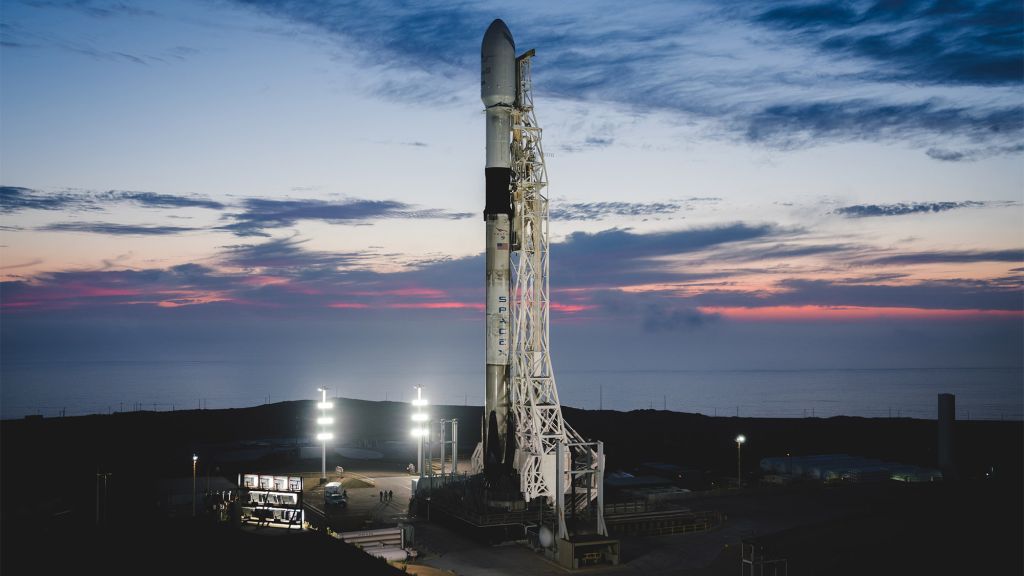SpaceX to launch Starlink and BlackSky satellites into orbit today. Here's how to watch live.
Liftoff is at 11:59 a.m. EDT (1559 GMT).

CAPE CANAVERAL, Fla. — SpaceX will launch its tenth set of Starlink internet satellites into orbit today (July 8), and you can watch it live online.
A SpaceX Falcon 9 rocket will launch the Starlink mission from Pad 39A at NASA's Kennedy Space Center in Florida. Liftoff is scheduled for no earlier than 11:59 a.m. EDT (1559 GMT). You can watch SpaceX's Starlink launch webcast here and on the Space.com homepage, courtesy of SpaceX, beginning about 15 minutes before liftoff. You'll also be able to watch the launch directly from SpaceX here.
Related: SpaceX's Starlink satellite megaconstellation launches in photos
This flight is SpaceX's tenth dedicated Starlink launch and the eighth such mission of 2020. Originally slated to launch on June 26, the flight was postponed after company engineers determined they needed to do more pre-flight checkouts.
On June 24, SpaceX fired up the rocket’s nine Merlin 1D engines as part of a routine static fire test. The test is designed to ensure that all the rocket’s systems are working properly prior to lift off.
That test appeared to go as planned, and SpaceX announced it would attempt the launch on June 26. However, just over two hours before liftoff, the company opted to stand down and put the rocket through some more testing.
To that end, SpaceX moved forward with the launch of an upgraded GPS satellite on June 30, and the mission went off without a hitch. The booster used in that mission recently returned to Port Canaveral on the deck of the company’s drone ship, Just Read the Instructions. That booster will be recycled to fly again another day.
Get the world’s most fascinating discoveries delivered straight to your inbox.
Now SpaceX has set its sights on Starlink once again. The booster used in this flight is a veteran with four flights under its belt already.
The rocket will attempt its fifth flight today, and just like the previous Starlink launch, the payload will contain other passengers. This flight will ferry two BlackSky satellites into orbit, as part of an ongoing rideshare agreement SpaceX has with Spaceflight, Inc.
The California-based rocket builder recently tweeted that more than 100 spacecraft have been booked on upcoming flights as part of the rideshare program. One such customer with multiple bookings is Spaceflight Inc., who arranged the ride for BlackSky.
Tucked inside the rocket’s nose cone is a stack of 57 Starlink satellites along with two Earth-observing satellites for BlackSky, marking the second official rideshare mission under SpaceX's new rideshare program. (The company had flown rideshare missions before, but now has a dedicated service.)
Related: SpaceX launches 60 Starlink satellites and lands rocket in dazzling nighttime liftoff
The star of today's mission is a previously flown booster, designated B1051 by SpaceX. It previously launched the Demo-1 mission in 2019, which sent an uncrewed Crew Dragon spacecraft to the International Space Station, a trio of Earth-observing satellites for Canada, as well as two Starlink missions this year.
SpaceX changed the rocket game by proving that they could be reused. Now, the company is staking its business on it as most of the rockets launched are veterans as opposed to new ones off the assembly line. In its rocket stable, SpaceX has five Falcon 9 first stage boosters as well as two Falcon Heavy side boosters.
Unfortunately, the company lost two first stages in back-to-back drone ship misses but that hasn't phased SpaceX as it gears up for another month of multiple launches. The private spaceflight company kicked off its rapid launch cadence with the launch of two NASA astronauts — Bob Behnken and Doug Hurley — on May 30.
The company followed that historic mission with three more launches in as many weeks. With the way the schedule is working out, we could see the same thing this month. On the docket is the launch of a South Korean communications satellite, an Argentinian communications satellite as well as another Starlink mission.
To date, SpaceX's Falcon 9 has flown 88 missions — 10 of which have launched this year. The company’s busiest year for launches was back in 2018 when the company launched 21 times. With the rapid launch pace SpaceX has set for itself and the need to get its Starlink satellites in orbit, the company could come close to those numbers this year.
To help increase the number of launches, SpaceX moved its former West Coast based drone ship, Just Read the Instructions to the East Coast to join its other ship, Of Course I Still Love You.
Related: Why SpaceX's Starlink satellites caught astronomers off guard
Forecasters at the 45th Weather Squadron show that the weather for today’s launch is looking promising, with a 40% chance of weather violation. Launching from Florida in the afternoon in summer can be tricky, and today is no different. However, the launch could be early enough in the day to get off the ground before bad weather rolls in. The weather officers say that the formation of cumulus clouds as well as the potential for electricity in the atmosphere are the primary concerns.
There’s a backup date of July 9, and the weather outlook increases slightly, with a 30% chance of violation.
SpaceX has also deployed its two fairing-catching ships — GO Ms. Tree and GO Ms. Chief — in hopes of recovering the Falcon 9's payload fairings after they fall back to Earth. The fairing halves are outfitted with software that navigates them to the recovery zone, as well as a parachute system that lets them gently land in the ocean or the outstretched net of the company’s twin recovery vessels.
Follow Amy Thompson on Twitter @astrogingersnap. Follow us on Twitter @Spacedotcom or Facebook.



